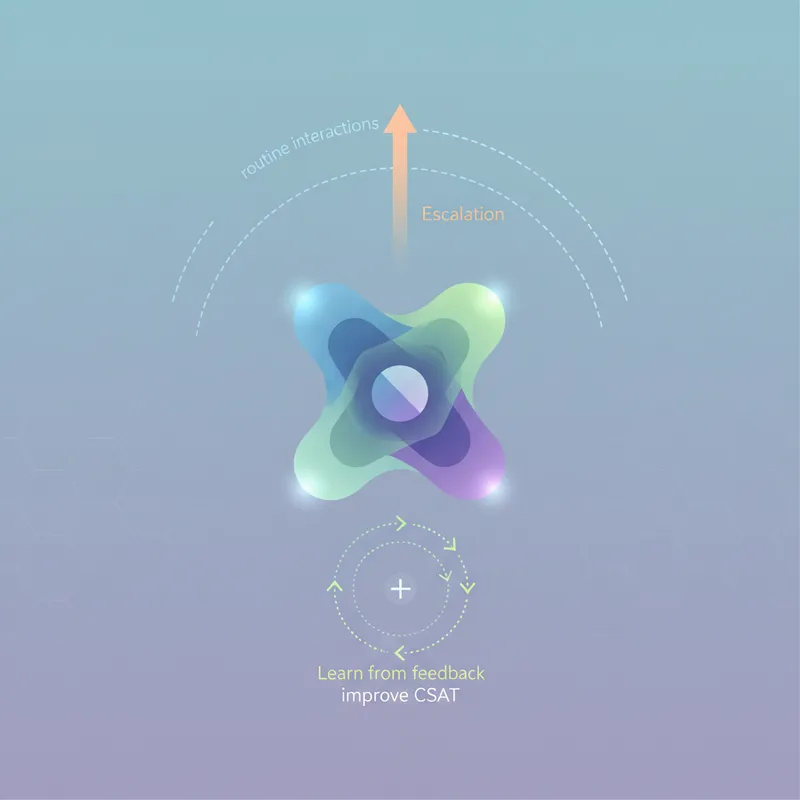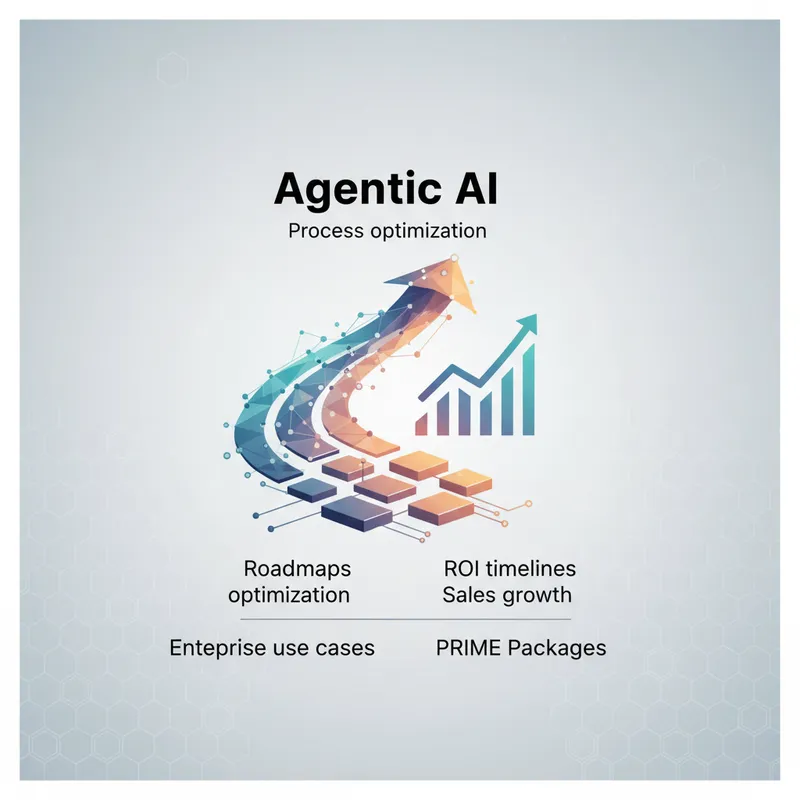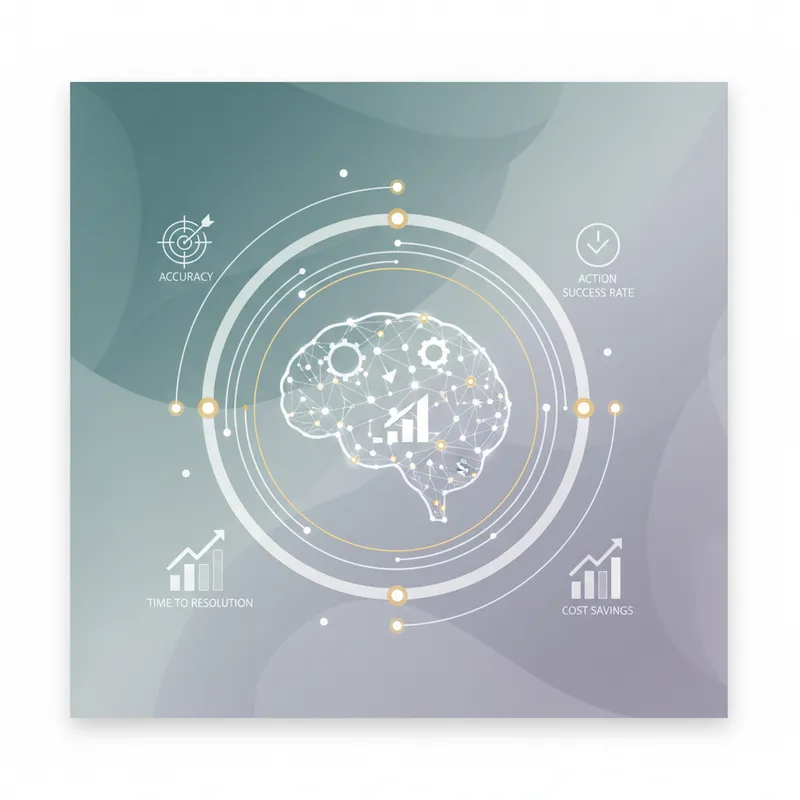
Introduction
Adopting agentic AI is no longer an experiment for forward looking teams. Measuring the financial impact early and often separates pilots that stagnate from programs that scale. This playbook focuses on agentic AI ROI and offers practical frameworks, templates, and step by step calculation methods to quantify cost savings, revenue uplift, and productivity gains from pilot to full scale implementations. You will get actionable spreadsheets, unit economics approaches, and guidance on how to present credible estimates to finance and executive stakeholders. The goal is to reduce uncertainty, align incentives, and create a repeatable path from a pilot to a sustainable production program.
Throughout this guide you will see how to structure hypotheses, gather the signals that matter, and translate technical outcomes into the language of business value. The methods work for internal agents that automate workflows, external facing agents that drive customer actions, and hybrid agents that combine both. By focusing on measurable inputs and conservative assumptions you can produce defensible agentic AI ROI estimates that support investment decisions and operational planning.
Why quantify agentic AI ROI now
Organizations are investing in agentic AI for a range of objectives including automation, personalization at scale, and improved decision support. However, investment without a clear quantification approach often yields limited adoption. A disciplined agentic AI ROI process helps prioritize use cases, set expectations, and identify the specific metrics to track during a pilot. When finance and product share a common model for ROI, projects move faster because trade offs are explicit and measurable. Learn more in our post on Agentic AI Solutions for Business: Packages, Use Cases, and ROI Estimates.
Quantification reduces the common risk that a pilot shows technical promise but fails to convert into margin improvement. Agents can change cost structures in ways that are non linear. For example, replacing a human error prone task with an autonomous agent can reduce rework, lower headcount exposure, and increase throughput simultaneously. A robust agentic AI ROI model captures all of those channels rather than focusing only on the most visible one.
Finally, measuring ROI early builds the organizational muscle to scale. Teams that deliver repeatable accounting of agentic AI ROI create templates for reuse across business units. Those templates accelerate decision cycles and allow centralized governance to focus on deployment risks and value leakage points instead of basic measurement disputes.
Frameworks to measure cost savings, revenue uplift, and productivity gains
Effective ROI frameworks split business impact into three primary buckets: cost savings, revenue uplift, and productivity gains. Each bucket has distinct measurement methods and timelines. When combined, they create a comprehensive picture of value across short term pilot results and longer term scale effects. Below are the framework components with practical guidance on how to collect inputs and compute outputs. Learn more in our post on Cost Modeling: How Agentic AI Lowers Total Cost of Ownership vs. Traditional Automation.
Cost savings framework
Cost savings are the most direct channel to capture agentic AI ROI. Start by mapping the current cost base for the process the agent will affect. Identify labor costs, error correction costs, system usage costs, and overhead allocations that are attributable to the process. For each category estimate the baseline metric that the agent will change, such as average handle time, error rate, or server compute consumption.
Use a conservative improvement assumption for pilots. For example, assume a 20 percent improvement in error rate reduction for early tests unless you have strong evidence to justify higher numbers. Multiply the baseline cost by the expected percentage change to estimate annualized savings. Adjust for implementation costs like data labeling, integration, and monitoring so you capture net savings. Include a retention factor to account for the share of savings that degrade over time due to process drift or rule changes.
Revenue uplift framework
Revenue uplift is often less direct but can be highly material. Agents that improve conversion, cross sell, or customer retention translate into net new revenue. To measure agentic AI ROI from revenue side, tie agent actions to a clear conversion funnel step and instrument the funnel to capture agent attribution.
Define the baseline conversion rate and the volume of opportunities. Estimate the incremental conversion lift attributable to the agent based on A B testing or matched control groups. Multiply incremental conversions by average order value and contribution margin to produce incremental contribution. Account for cannibalization and channel shifts by subtracting displaced revenue. If the agent also enables pricing or premium offers, include the incremental margin impact rather than gross sales only.
Productivity gains framework
Productivity gains capture additional output resulting from the same or fewer resources. This bucket is critical when agents augment knowledge workers and unlock higher throughput. For productivity, measure units processed per worker hour, cycle times, or decision latency. The agentic AI ROI calculation converts productivity improvements into full time equivalent reductions or freed capacity that can be redeployed to revenue generating tasks.
Estimate the economic value of freed capacity conservatively. Not all freed hours translate to payroll reductions. They may be reallocated to higher margin work. Model two scenarios: redeployment versus headcount reduction. Apply realistic timelines for workforce changes because headcount reductions come with separation costs and transition friction.
Bringing the three frameworks together
Combine cost savings, revenue uplift, and productivity gains into a single financial view. Use a multi year horizon such as three years to capture both immediate pilot benefits and scale effects. Discount future benefits appropriately if you need to present net present value. Include a one time implementation cost line that covers engineering, data, security, and change management. Present both pre tax and after tax returns if your stakeholders require tax adjusted figures.
Below is a simple checklist to ensure completeness of inputs when computing agentic AI ROI
- Baseline volumes and rates for each impacted metric
- Projected percentage change from the agent for each metric
- Implementation and ongoing operating costs
- Attribution method and confidence level
- Scaling assumptions and retention factors
- Risk adjustments for uncertainty and model validation
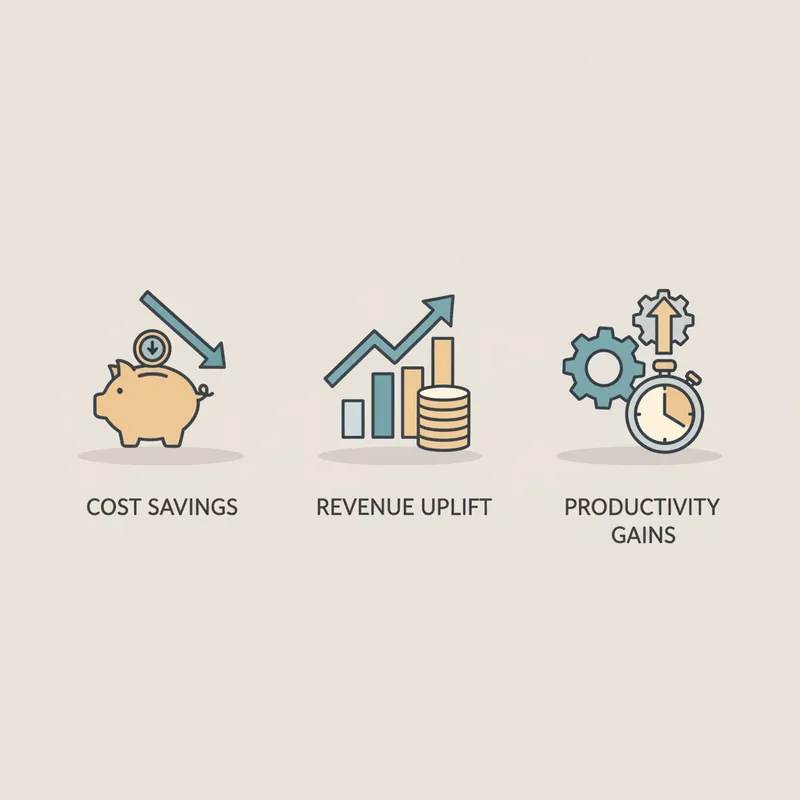
Pilot to full scale templates and sample calculations
Turning a pilot into a scaled agentic AI program requires repeatable templates for data collection, measurement, and forecasting. Start with a pilot template that focuses on narrow, measurable objectives. The template should specify hypothesis, primary metric, secondary metrics, control group methodology, data sources, and a small set of stop and go criteria. Learn more in our post on Security and Compliance for Agentic AI Automations.
Below is a sample pilot template structure you can copy and adapt
- Objective: Clear statement of expected business outcome and time horizon
- Hypothesis: What will change and why the agent will deliver it
- Primary metric: The main KPI used to quantify agentic AI ROI
- Secondary metrics: Supporting measures such as latency, false positive rate, and customer satisfaction
- Control plan: A randomized or matched control approach to ensure attribution
- Data pipeline: Sources, frequency, and owners
- Cost log: All incremental implementation and operating costs
- Governance: Roles for product, engineering, data, security, and finance
For a common use case such as automated claims triage, here is a compact sample calculation to illustrate agentic AI ROI
- Baseline: 10,000 claims per month, average cost per claim investigated 50, error rate 8 percent
- Pilot assumption: Agent reduces manual triage time by 30 percent and reduces error rate from 8 percent to 5 percent
- Calculate monthly labor savings: baseline labor cost = 10,000 claims times 50 equals 500,000. Time reduction 30 percent yields 150,000 saved monthly
- Calculate error reduction savings: baseline error cost = 10,000 claims times 8 percent times 200 cost per error equals 160,000. New error cost at 5 percent equals 100,000. Monthly error savings equals 60,000
- Net monthly benefit: 150,000 plus 60,000 equals 210,000
- Implementation cost: one time 300,000 and monthly operating cost 20,000
- First year ROI: annualized benefit 2,520,000 minus implementation 300,000 and ops 240,000 equals 1,980,000 net. Simple payback less than one quarter. Present conservative ranges using sensitivity analysis.
When building scale forecasts, layer in realistic constraints. Consider data drift, regulatory reviews, and cross functional coordination overhead. Use versioned scenarios such as conservative, base case, and optimistic. In each scenario, adjust retention factors and adoption rates. Adoption is a critical lever. A 10 percent adoption difference across business units can swing agentic AI ROI materially.
Use this forecasting approach to communicate expected timing of returns. Many stakeholders want early clarity on payback and ongoing run rate. Show monthly cash flow for the first 12 months and annualized impacts for years two and three. Include a sensitivity table that varies key assumptions like conversion lift, error reduction, and ongoing unit costs.
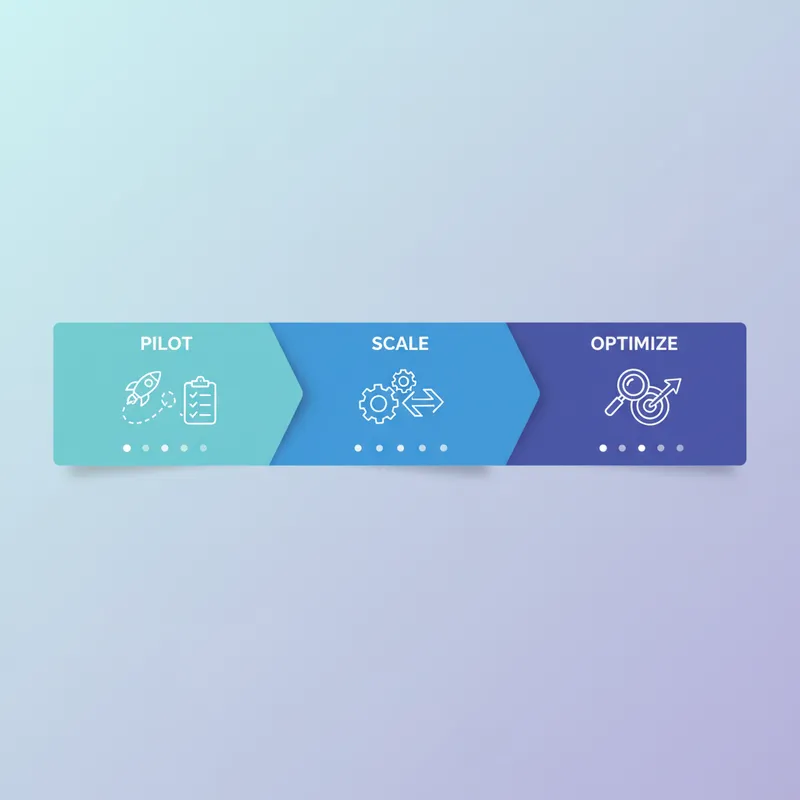
Measuring intangible benefits and applying risk adjustments
Not all benefits from agentic AI are directly monetizable in the short term. Intangible benefits include improved customer satisfaction, faster decision quality, reduced compliance risk, and better employee engagement. These benefits affect long term value and support strategic arguments even if the immediate cash impact is small.
To include intangible benefits in your agentic AI ROI framework, use a three step process. First, quantify where possible using proxy metrics. For example customer satisfaction improvements can be converted into projected retention gains using historical correlation studies. Second, assign a confidence level to each intangible benefit. Third, apply a probability weighted value before combining with hard financials. This converts intangibles into a conservative contribution to net present value rather than overstating impact.
Risk adjustments are essential because early agentic AI projects face multiple uncertainties. Common risk factors include data quality and coverage, operational integration, regulatory scrutiny, and technical performance degradation over time. For each risk, estimate a likelihood and impact then compute a risk reserve or contingency that reduces your headline ROI. Finance teams prefer to see an explicit risk adjusted return to compare across investments.
Here is a simple risk adjustment method
- List top five project risks
- For each, assign probability p between 0 and 1 and impact I in dollars if the risk materializes
- Compute expected loss as p times I and sum across all risks
- Subtract total expected loss from projected benefits to get risk adjusted agentic AI ROI
When presenting results, include two columns: gross benefit and risk adjusted benefit. This transparency increases trust and helps stakeholders understand where to focus mitigation efforts. Also track realized versus projected benefits after pilot completion and update future forecasts with observed lift and operating metrics.
Operational playbook: governance, measurement cadence, and tooling
Operationalizing agentic AI ROI measurement requires clear governance and a regular measurement cadence. Set up a cross functional steering committee with finance, product, data, security, and operations represented. The committee reviews pilot progress, validates assumptions, and approves scale gating. Include explicit success criteria and a timeline for re measurement after deployment to ensure benefits persist.
Measurement cadence should include daily operational dashboards for health metrics, weekly roll ups for performance metrics, and monthly financial reconciliations. Health metrics cover latency, throughput, and error rates. Performance metrics track the KPI the pilot is designed to improve. Financial reconciliations compare realized savings or revenue against forecast. Automate as much of the data pipeline as possible to reduce manual reconciliation effort.
Choose tooling that supports attribution and auditability. Ensure data lineage is clear so finance can reconcile the agentic AI ROI numbers with source systems. Use feature flags and traffic splitting to run controlled experiments and ramp up agents while maintaining fallback options. Maintain a cost registry to track ongoing cloud compute, model updates, and human oversight costs separately from one time integration efforts.
Operationalize continuous validation to detect model drift and performance decay. Build a schedule for periodic retraining and a plan for human review of edge cases. Include a burn in period post deployment where you compare predicted versus actual impact and apply retrospective adjustments to your ROI model. This creates a feedback loop that improves future forecasts and reduces over optimism.
Finally, foster an internal library of ROI playbooks and templates. Standardize taxonomies for benefit types, measurement methods, and risk categories. This library becomes the single source of truth for new teams launching agentic AI pilots and accelerates the journey from pilot to proven scale.

Common pitfalls and mitigation strategies
Several pitfalls repeatedly undermine clear measurement of agentic AI ROI. The first is attributing benefit to the agent without a control. Always maintain an A B or matched control when possible. The second pitfall is over indexing on model accuracy as a proxy for business impact. High accuracy does not necessarily equal high ROI. Link model outputs to business actions and measure the end to end impact.
Another common failure is neglecting total cost of ownership. Pilot cost estimates often omit ongoing monitoring, data labeling, and security compliance costs. Include all recurring operating expenses in your ROI model. Finally, organizational change is often underestimated. Agents change workflows and require retraining of staff. Build change management line items into your implementation costs and timeline assumptions.
Mitigations are straightforward. Use conservative assumptions, require control groups or phased rollouts, maintain a transparent cost registry, and allocate explicit change management budgets. Monitor early indicators closely and be willing to pause or roll back when performance deviates materially from forecast.
Checklist and next steps for teams
Here is a compact checklist you can use to move from concept to financial approval for an agentic AI pilot
- Define the business objective and primary metric for agentic AI ROI
- Build a baseline data snapshot and confirm measurement methods
- Create pilot template with hypothesis, control plan, and governance
- Estimate conservative, base, and optimistic scenarios with implementation and operating costs
- Run pilot with control group and collect monthly financial reconciliation
- Compute gross and risk adjusted agentic AI ROI and present to stakeholders
- Prepare scale roadmap with adoption targets, monitoring cadence, and retraining plan
Next steps for most teams include selecting an initial high value use case, assembling the cross functional team, and running a short time boxed pilot to produce the first verified ROI numbers. Prioritize use cases that have clear metrics and manageable data scope to reduce measurement friction.
Conclusion
Quantifying agentic AI ROI is essential to move from exploratory pilots to durable, scaled programs that deliver business value. A disciplined approach combines three impact buckets cost savings, revenue uplift, and productivity gains into a unified forecast. Using conservative assumptions, a clear attribution plan, and explicit risk adjustments creates credible, finance grade estimates. Equally important is the operational work that follows measurement. Governance, a steady measurement cadence, and automated data pipelines ensure that early pilot results are validated and preserved over time.
Practical templates reduce repeated debate and accelerate decision making. Start small with narrow pilots that have clear success criteria and a defined control plan. Use sensitivity analysis to show the range of possible returns and provide a risk adjusted column to account for technical and operational uncertainty. Communicate results in terms finance values such as payback, net present value, and contribution margin so stakeholders can compare the agentic AI ROI to other investment opportunities.
Remember that some benefits will be intangible and require proxy conversions to convert into financial terms. Apply probability weighting and conservative proxies so these contributions are credible. Build a central repository of ROI playbooks to capture what worked and what did not so future projects learn from past assumptions and outcomes. Over time this library becomes the engine for repeatable, scalable impact across the organization.
Teams that treat agentic AI ROI as a continuous engineering and measurement problem will be able to prioritize the highest value opportunities, reduce deployment risk, and create sustainable economic benefit. The frameworks here are designed to be practical and repeatable. Use them to create pilot templates, run controlled experiments, and produce risk adjusted forecasts that support investment decisions. With the right discipline and transparency you can turn promising agentic AI pilots into predictable sources of cost reduction, revenue growth, and productivity improvement.

